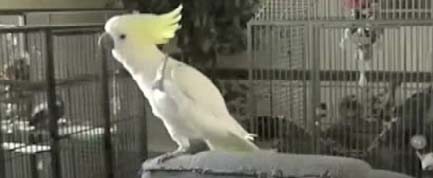These Birds Can Dance!

They might not be able to get a spot in a Broadway show, but some birds can dance.
Dancing as we think of it has generally been thought to be a skill that only humans possessed (well, some of us). But a new study finds that certain species of parrot can bob their heads, tap their feet and sway along with the music.
The findings, detailed May 26 issue of the journal Current Biology, might actually shed light on how humans came to invent steps from the waltz to the Electric Slide.
Story continues below...
{{ video="LS_090430_dancing-birds" title="Birds Boogie to Beat" caption="Snowball the cockatoo and Alex the African grey parrot bob their heads and tap their feet to different beats. "Dancing" was previously only thought to be a human behavior. Credit: Current Biology" }}
Adena Schachner, a graduate student at Harvard, and her colleagues studied Alex, the famous African grey parrot, and Snowball, a sulfur-crested cockatoo (Cacatua galerita eleonora) and found that they "danced" to the beat of human music.
Snowball's moves even brought him online fame. One of Snowball's favorite tunes to get down to was the Backstreet Boys' "Everybody."
Get the world’s most fascinating discoveries delivered straight to your inbox.
Dancing had long been thought to be a solely human habit because, "there is no convincing evidence that our closest relatives, chimpanzees and other apes, can keep a beat, and there is similarly no evidence that our pet dogs and cats can line up their actions with a musical beat, in spite of extensive experience with humans," Schachner said.
The home videos that garnered Snowball fame on YouTube led Schachner and her colleagues to study the cockatoo's avian groove more closely.
"Our analyses showed that these birds' movements were more lined up with the musical beat than we'd expect by chance," Schachner said. "We found strong evidence that they were synchronizing with the beat, something that has not been seen before in other species."
So why cockatoos and not chimps? The answer may be an ability that Alex and Snowball (and humans) have in common: vocal mimicry.
Scientists recently proposed that the same brain mechanisms that were selected by evolution to allow for vocal mimicry also allow an animal to keep a beat. For both mimicry and dance, you're listening to a sound and constantly monitoring both your output (the vocal sounds you make or the tapping of your foot) and the sound coming in through your ears.
Schachner and her colleagues tested this idea by searching the YouTube database for videos of animals, including mimics and non-mimics (such as cats and dogs), moving along with a musical beat. The work was funded by the McDonnell Foundation.
They ruled out potentially "fake" videos where music was added afterwards or the animal was following some visual movement.
All the animals whose speed matched that of the music and kept in time with the beat were vocal mimics, including 14 species of parrot and one species of elephant.
"Our data suggests that some of the brain mechanisms needed for human dance originally evolved to allow us to imitate sound," Schachner said.
- Video – See Alex and Snowball's Moves
- 10 Amazing Things You Didn't Know About Animals
- Images: Rare and Exotic Birds

Andrea Thompson is an associate editor at Scientific American, where she covers sustainability, energy and the environment. Prior to that, she was a senior writer covering climate science at Climate Central and a reporter and editor at Live Science, where she primarily covered Earth science and the environment. She holds a graduate degree in science health and environmental reporting from New York University, as well as a bachelor of science and and masters of science in atmospheric chemistry from the Georgia Institute of Technology.


